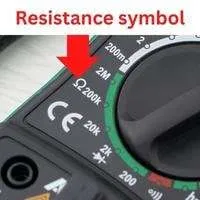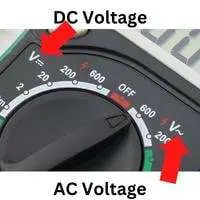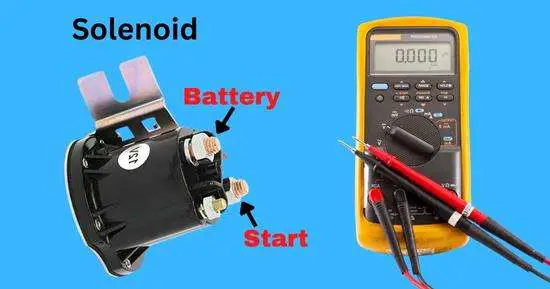A solenoid or starter coil is an essential component of your vehicle’s engine that aids in converting the battery’s voltage to start your engine by converting electrical energy into mechanical energy.
The starter solenoid has two coils wrapped around two moveable iron cores inside the metal cover of the solenoid. However, the outer side of the solenoid has 3 terminals, two large and one small. Two large (same-sized) terminals are for the battery and solenoid, and the third smaller terminal is for the starter control wire that connects to the ignition switch.
Table of Contents
ToggleHow to test solenoid with a multimeter?
Make sure to wear gloves and connect your solenoid to a battery.
- To test a solenoid, connect your solenoid to a power source.
- Measure resistance in both large terminals of the solenoid.
- Resistance in your solenoid can be different from other models, so compare the multimeter readings with the ideal range in the manual.
- Now set your multimeter to AC voltage and check the voltage at the terminals of the solenoid.
- Your solenoid should have around 12V if you are testing a solenoid with a car battery.
Below we’ve explained a complete step-by-step guide to test your solenoid coil to identify a fault.
Test 1: Test resistance in the solenoid
To check a solenoid, we’ll measure resistance in the solenoid terminal with a multimeter while connected and disconnected to a battery.
A solenoid coil is usually between the vehicle’s ignition module and the engine. If the solenoid coil is not removed from the vehicle, you’ll have to locate it and turn on the engine when testing it.
A positive battery terminal wire goes to the solenoid’s B terminal. At the S(solenoid) terminal, a wire from the ignition switch is connected. We have to test these two terminals in each test.
If you have removed the solenoid from the engine, you’ll have to connect the solenoid coil to the battery with jumper wires. Take two jumper wires and connect them from both battery terminals to both large and equal-sized terminals(pins) in the solenoid coil.
First of all, set your multimeter to ohms in the 200Ω range. Connect both multimeter probes to the same sizing terminals. When the solenoid is disconnected from the battery multimeter should have some resistance.
Different solenoid models and make can have different resistance ranges. You should consult the manufacturer’s manual and compare the multimeter readings with the ideal range.
Now, if we supply current to the solenoid through the battery or mount the coils in the engine, the multimeter will read around 1 ohm in the solenoid.
If your solenoid has 0 ohms while attached to a power supply, the solenoid is short-circuited. The solenoid circuit is damaged or broken if the multimeter reads too high resistance or OL(open loop).
Remember that the outer metal body of the solenoid should not have any conductivity(connection). To check the resistance between the ground(body) and the solenoid terminals, connect one probe to the metal body and the other probe to both terminals.
The multimeter should read OL, meaning there is no continuity, and the circuit is not shorted.
Test 2: Test voltage in the solenoid
Now we’ll test the voltage of the solenoid coil when it is connected to a battery or mounted in the engine.
A solenoid is an electromechanical component that converts AC or DC voltage to run the engine and move your vehicle.
So we can select AC or DC voltage settings on your multimeter. Set a range above the voltage of the battery connected to the circuit.
Make sure that the solenoid is connected to a battery. You can use jumper wires and alligator clips to connect the solenoid directly to the battery. Or you can test the solenoid after installing it in the engine.
Now connect both multimeter probes to the large and same-sized terminals on the solenoid.
The multimeter should read the voltage near the battery attached to the solenoid. If you are testing solenoids with a car battery (in the engine), the multimeter should read around your car battery’s voltage, such as 12-12.6V.
If the solenoid gets too low voltage, the battery is not charged, circuit wires are damaged, or the solenoid itself is faulty.
Signs of a faulty solenoid
Due to a defective solenoid:
- The engine will crank but doesn’t start.
- There is no clicking sound from the solenoid when the engine starts.
- The solenoid is not getting enough voltage.
- Your car may sometimes start when the ignition key is turned to the start position.
- How to test a solenoid without a multimeter
Frequently Asked Questions
- How to test a solenoid without a multimeter?
Ask someone to start the engine through the ignition key. Stand near the engine and try to notice click sound from the solenoid coils.
If the click noise is loud(strong), the solenoid coils in power and works well. However, low or no click means your solenoid coils are weak. It’s an easy test to perform without using any tool.
- How to check solenoid coil resistance?
To check solenoid coil resistance:
-
- Connect the solenoid to a battery and set your multimeter to ohms.
- Connect both multimeter probes to the large terminals on the solenoid. Your multimeter will read the resistance is your solenoid.
- Compare the multimeter with the ideal range of your specific solenoid model.
- How to test a solenoid with a battery?
Connect the solenoid to the battery or mount it inside an engine. Take a light tester(test light) and connect it to the negative battery terminal. Start the engine(crank)and connect the light tester probe to the solenoid terminals. If your solenoid is OK, a bulb in the test light should glow when you start the engine and reach the solenoid.
Conclusion
So if you have doubts about the solenoid’s functioning, the best method to test is by checking the resistance and voltage in the solenoid coils. Make sure to wear gloves and connect your solenoid to a power supply.
It’s recommended to compare the multimeter readings with the ideal resistance and voltage ranges of the model used in your vehicle. Different make and models can have different ranges of resistance and voltage.
Hopefully, the explanation above will help you to figure out a fault in your vehicle’s solenoid coils.
Related Guides




